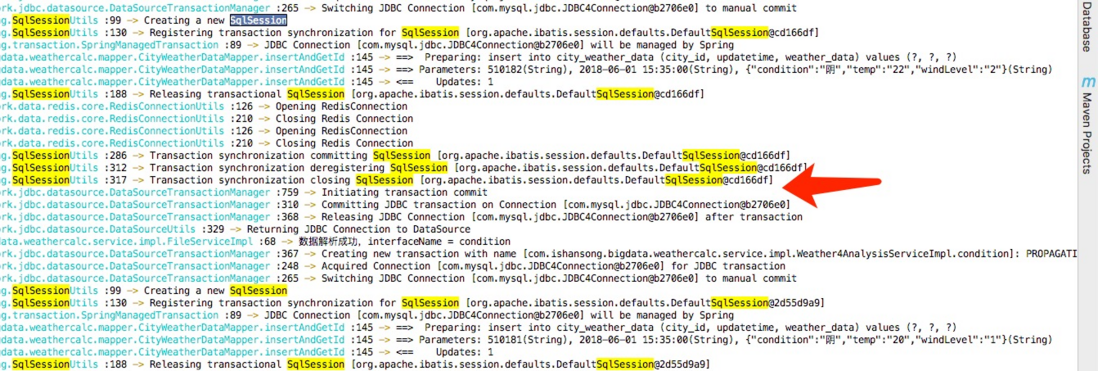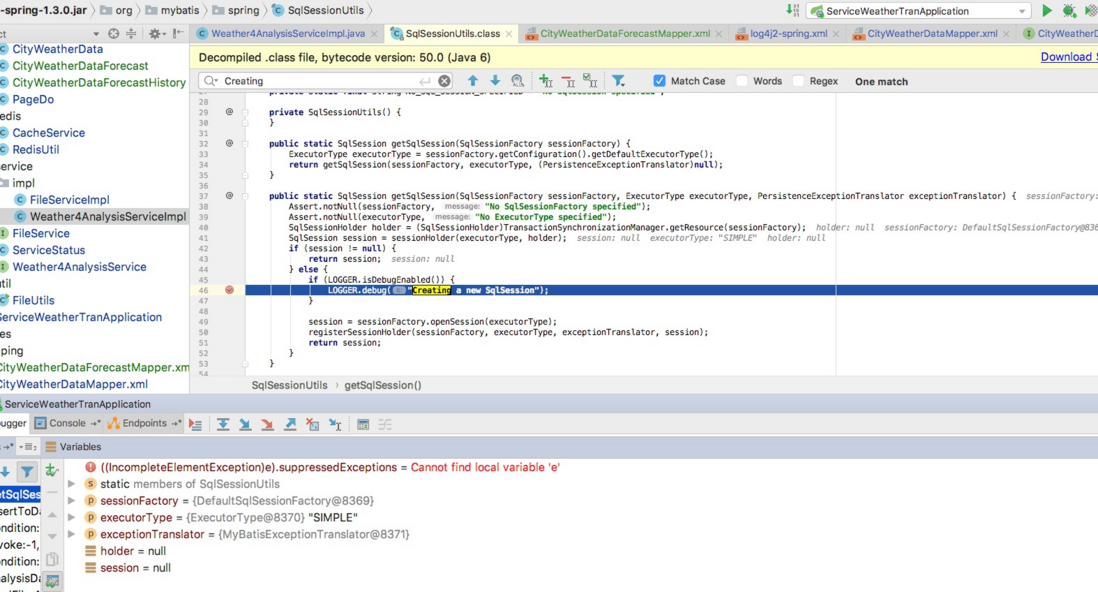问题记录:
工作环境是使用spring boot,使用用的mybatis,在一次调试中。发现每一次插入一条
数据都会创建一个SqlSession。如图:图1:
问题可能的原因:
原因分析:#1 没有使用缓存
因为这个是插入,不是查询,所以这里不存在什么缓存的问题。后来百度了一波,网上说是没有使用事务。加上@Transactional
图2:
发现“Creating a new SqlSession”这两个烦人的东西居然还在。不管了,直接分析源码
直接分析源码,老子还不信了,搞不定你我还混什么:
1.开启debug
2.打上断点图3:
发现session为空
继续走...
图2 #分析
public static SqlSession getSqlSession(SqlSessionFactory sessionFactory, ExecutorType executorType, PersistenceExceptionTranslator exceptionTranslator) {
//从从前线程的threadLocal 中获取sqlSessionHolder
SqlSessionHolder holder = (SqlSessionHolder)TransactionSynchronizationManager.getResource(sessionFactory);
//调用静态方法sessionHoler 判断是否存在符合要求的sqlSession
SqlSession session = sessionHolder(executorType, holder);
// 判断当前sqlSessionHolder 中是否持有sqlSession (即当前操作是否在事务当中)
if (session != null) {
//如果持有sqlSesison 的引用,则直接获取
return session;
}
if (LOGGER.isDebugEnabled()) {
LOGGER.debug("Creating a new SqlSession");
}
//获取新的sqlSession 对象。这里由sessionFacory产生的defaultSqlSession
session = sessionFactory.openSession(executorType);
//判断判断,当前是否存在事务,将sqlSession 绑定到sqlSessionHolder 中,并放到threadLoacl 当中
registerSessionHolder(sessionFactory, executorType, exceptionTranslator, session);
return session;
}图3 #分析
private static SqlSession sessionHolder(ExecutorType executorType, SqlSessionHolder holder) {
SqlSession session = null;
if (holder != null && holder.isSynchronizedWithTransaction()) {
//hodler保存的执行类型和获取SqlSession的执行类型不一致,就会抛出异常,也就是说在同一个事务中,执行类型不能变化,原因就是同一个事务中同一个sqlSessionFactory创建的sqlSession会被重用
if (holder.getExecutorType() != executorType) {
throw new TransientDataAccessResourceException("Cannot change the ExecutorType when there is an existing transaction");
}
//增加该holder,也就是同一事务中同一个sqlSessionFactory创建的唯一sqlSession,其引用数增加,被使用的次数增加
holder.requested();
if (LOGGER.isDebugEnabled()) {
LOGGER.debug("Fetched SqlSession [" + holder.getSqlSession() + "] from current transaction");
}
//返回sqlSession
session = holder.getSqlSession();
}
return session;
}当然,这里还少了一个注册的方法,贴上:
private static void registerSessionHolder(SqlSessionFactory sessionFactory, ExecutorType executorType,PersistenceExceptionTranslator exceptionTranslator, SqlSession session) {
SqlSessionHolder holder;
//判断事务是否存在
if (TransactionSynchronizationManager.isSynchronizationActive()) {
Environment environment = sessionFactory.getConfiguration().getEnvironment();
//加载环境变量,判断注册的事务管理器是否是SpringManagedTransaction,也就是Spring管理事务
if (environment.getTransactionFactory() instanceof SpringManagedTransactionFactory) {
if (LOGGER.isDebugEnabled()) {
LOGGER.debug("Registering transaction synchronization for SqlSession [" + session + "]");
}
holder = new SqlSessionHolder(session, executorType, exceptionTranslator);
//如果当前回话处在事务当中,则将holder 绑定到ThreadLocal 中
//以sessionFactory为key,hodler为value,加入到TransactionSynchronizationManager管理的本地缓存ThreadLocal<Map<Object, Object>> resources中
TransactionSynchronizationManager.bindResource(sessionFactory, holder);
//将holder, sessionFactory的同步加入本地线程缓存中ThreadLocal<Set<TransactionSynchronization>> synchronizations
TransactionSynchronizationManager.registerSynchronization(new SqlSessionSynchronization(holder, sessionFactory));
//设置当前holder和当前事务同步
holder.setSynchronizedWithTransaction(true);
//holder 引用次数+1
holder.requested();
} else {
if (TransactionSynchronizationManager.getResource(environment.getDataSource()) == null) {
if (LOGGER.isDebugEnabled()) {
LOGGER.debug("SqlSession [" + session + "] was not registered for synchronization because DataSource is not transactional");
}
} else {
throw new TransientDataAccessResourceException( "SqlSessionFactory must be using a SpringManagedTransactionFactory in order to use Spring transaction synchronization");
}
}
} else {
if (LOGGER.isDebugEnabled()) {
LOGGER.debug("SqlSession [" + session + "] was not registered for synchronization because synchronization is not active");
}
}}
补充
-
sqlSessionHolder 继承了spring的ResourceHolderSupport
public abstract class ResourceHolderSupport implements ResourceHolder { //事务是否开启private boolean synchronizedWithTransaction = false; private boolean rollbackOnly = false; private Date deadline; // 引用次数 private int referenceCount = 0; private boolean isVoid = false; }
-
在sqlSession 关闭session 的时候, 使用了工具了sqlSessionUtils的closeSqlSession 方法。sqlSessionHolder 也是做了判断,如果回话在事务当中,则减少引用次数,没有真实关闭session。如果回话不存在事务,则直接关闭session
public static void closeSqlSession(SqlSession session, SqlSessionFactory sessionFactory) { notNull(session, NO_SQL_SESSION_SPECIFIED); notNull(sessionFactory, NO_SQL_SESSION_FACTORY_SPECIFIED); SqlSessionHolder holder = (SqlSessionHolder)TransactionSynchronizationManager.getResource(sessionFactory); //如果holder 中持有sqlSession 的引用,(即会话存在事务) if ((holder != null) && (holder.getSqlSession() == session)) { if (LOGGER.isDebugEnabled()) { LOGGER.debug("Releasing transactional SqlSession [" + session + "]"); } //每当一个sqlSession 执行完毕,则减少holder 持有引用的次数 holder.released(); } else { if (LOGGER.isDebugEnabled()) { LOGGER.debug("Closing non transactional SqlSession [" + session + "]"); } //如果回话中,不存在事务,则直接关闭session session.close(); } }到了这一步,问题已经很明显了。
出现原因 与 分析
- SqlSessionHolder holder = (SqlSessionHolder)TransactionSynchronizationManager.getResource(sessionFactory); 这一句:他从从前线程的threadLocal 中获取sqlSessionHolder。但是在在sqlSession 关闭session 的时候,sqlSessionHolder也是做了判断。如果会话在事务中,就减少引用次数,没有真实关闭session。如果会话不存在事务,则直接关闭session。也就是说,必须开启事务,但这个问题好像只是插入了一下,事务已经执行完成了,下一次插入的时候,由于上一个事务执行完成了, 如果不存在holder或没有被事务锁定,则会创建新的sqlSession,即 Creating a new SqlSession,通过sessionFactory.openSession()方法。如果会话不存在事务,就直接把session关闭了,同时,也减少了引用次数。
- 换一句话来说:如果在插入的代码块中,再加上一个查询的代码,或者再插入一条数据的代码,这样就不会出现Creating a new SqlSession这个烦人的家伙。好了,祝大家好运!!!
引用:
SqlSessionHolder作用
如果有侵权,马上删除




**粗体** _斜体_ [链接](http://example.com) `代码` - 列表 > 引用。你还可以使用@来通知其他用户。